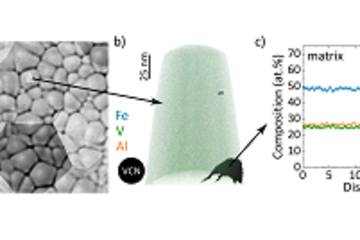All genres
2421.
Thesis - PhD
Micromechanically guided design of graded ultrafine-grained dual-phase steel. Dissertation, Ruhr-Universität Bochum, Bochum, Germany (2015)
2422.
Thesis - PhD
Designing ductile martensitic steel microstructures via localised austenite formation controlled by tailored chemical gradients. Dissertation, RWTH Aachen University, Aachen, Germany (2015)
2423.
Thesis - PhD
Segregation driven phase transformation in medium Mn steel. Dissertation, RWTH Aachen University, Aachen, Germany (2015)
2424.
Thesis - PhD
High Resolution Crystal Plasticity Simulations. Dissertation, Aachen Institute for Advanced Study in Computational Engineering Science (AICES), RWTH Aachen University, Aachen, Germany (2015)
2425.
Thesis - PhD
On the nano-scale characterization of kesterite thin-films. Dissertation, RWTH Aachen University, Aachen, Germany (2015)
2426.
Thesis - PhD
Thermal stability of AlN/CrN superlattice hard coatings. Dissertation, RWTH Aachen University, Aachen, Germany (2015)
2427.
Thesis - PhD
Micromechanical modeling of martensitic phase transformation in steels based on non-local crystal plasticity. Dissertation, Ruhr-Universität Bochum, Bochum, Germany (2015)
2428.
Thesis - PhD
Nucleation of Mo-rich Laves phase particles in 12% Cr steels. Dissertation, Ruhr-Universität Bochum, Bochum, Germany (2014)
2429.
Thesis - PhD
Dynamic correlations and confinement effects in glass forming hard sphere systems. Dissertation, RWTH Aachen, Aachen, Germany (2014)
2430.
Thesis - PhD
Molecular Dynamics Studies of Thermodynamical Consistency and Non-locality of Effective Temperature. Dissertation, Aachen Institute for Advanced Study in Computational Engineering Science (AICES), RWTH Aachen University, Aachen, Germany (2014)
2431.
Thesis - PhD
The inheritance of different microstructures found after hot rolling on the properties of a completely annealed dual phase steel. Dissertation, Fakultät für Georessourcen und Materialtechnik, RWTH Aachen, Aachen, Germany (2014)
2432.
Thesis - PhD
Feasibility study on local elastic strain measurements with an EBSD pattern cross correlation method in elastic-plastically deforming material. Dissertation, RWTH Aachen, Aachen, Germany (2014)
2433.
Thesis - PhD
Co-deformation of Amorphous CuZr/Nanocrystalline Cu Multilayers. Dissertation, Fakultät für Maschinenbau, Ruhr-Universität Bochum, Bochum, Germany (2014)
2434.
Thesis - PhD
Fe–Mn–Pd maraging steels for biodegradable implant applications. Dissertation, Materials Science, ETH Zurich, Zürich, Switzerland (2014)
2435.
Thesis - PhD
Atomic scale investigation of clustering and nanocrystallization in FeSiNbB(Cu) soft magnetic amorphous alloys. Dissertation, RWTH-Aachen, Aachen, Germany (2014)
2436.
Thesis - PhD
Structure-property-relations of cuticular photonic crystals evolved by different beetle groups (Insecta, Coleoptera). Dissertation, RWTH-Aachen, Aachen, Germany (2014)
2437.
Thesis - PhD
On the role of dislocation transport in the constitutive description of crystal plasticity. Dissertation, RWTH Aachen, Aachen, Germany (2013)
2438.
Thesis - PhD
Pulsed Plasma Nitriding - Effect on Hydrogen Embrittlement and Hydrogen Adsorption and Diffusion. Dissertation, Norwegian University of Science and Technology NTNU, Trondheim, Norway (2013)
2439.
Thesis - PhD
Lattice Boltzmann modeling of advection-diffusion-reaction equations in non-equilibrium transport processes. Dissertation, RWTH Aachen, Aachen, Germany (2013)
2440.
Thesis - PhD
A constitutive model of twin nucleation and deformation twinning in High-Manganese Austenitic TWIP steels. Dissertation, RWTH Aachen, Aachen, Germany (2013)










